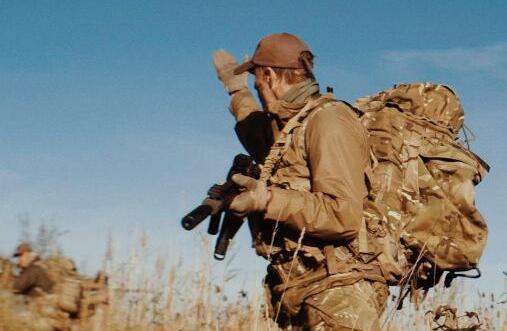
14 minute read
CRFS - Covert RF surveillance
Covert RF surveillance
The commandos were dug in and well-camouflaged as they observed the enemy talking on the radio before them. They had been watching the track for some time and now finally had confirmation that the area was being used by the enemy.

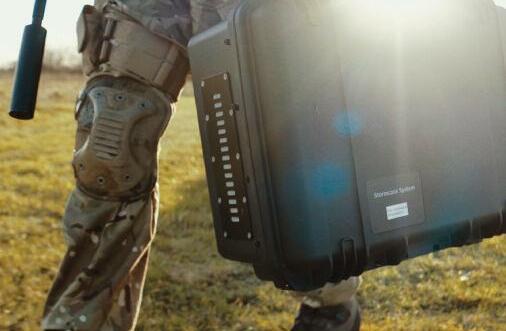
But what was the enemy’s intent? And where were they heading? Following them would be too risky, but if the enemy were using radios, there was intelligence to be gained.
The covert nature of the mission meant moving COMINT trucks into the area was out of the question. Fortunately, the troops had a trick up their sleeve. The commandos had brought three RFeye Stormcases with them. The self-contained Signals Intelligence (SIGINT) system was set up and activated in a matter of minutes. At a flick of a switch, they could now gather the all-important COMINT needed. But this wasn’t all the Stormcases were there for.
Frequencies
The RFeye Stormcase is versatile kit. Covering frequencies of 9 kHz to 18/40 GHz it not only collects COMINT on radios transmitting on HF and V/UHF wavebands, but also collects SIGINT on a range of emitters including radars and satellite communications. With low noise figures, few signals escape the system’s attention, even when using low power to obfuscate their existence. Furthermore, while one RFeye Stormcase comfortably collects SIGINT across these frequencies, the use of 3 or more allows emitters to be accurately located using live or post-processed TDOA geolocation. And that’s exactly what our commandos in the story did. By placing three RFeye Stormcases in various locations around the area of interest, not only could they collect COMINT, but also valuable geolocation intelligence on where these transmissions were coming from.
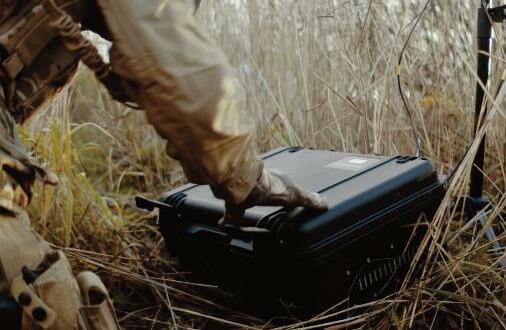
Ease of Use
We sat down with Malcolm Sellars – product management lead to find out more.
“The idea of the Stormcase was to make it as portable as possible for a quick deployment, ” said Malcolm. It can be comfortably carried in a rucksack by one person, and or discreetly transported and used in a vehicle. Malcolm says that time spent consulting with customers on what they need in a deployable signals intelligence gathering system was gold dust. Customers told him that they needed an easily deployable, selfcontained design. “You don’t have to worry about power supply cables or weather proofing, ” said Malcolm (CRFS Product Management Team).
The Stormcase was designed from the outset to be used by the untrained operator. In other words, squaddie-friendly, or gruntproof. Malcolm commented, “The RFeye Stormcase was specially designed to have simple configuration, even with gloved hands. The operators just needs to flick a switch and the equipment starts its mission. This ensures minimum deployment time and low observability so that it can be quickly and easily concealed.
The RFeye Stormcase can be left hidden and unattended recording signals of interest: “A soldier could dismount from their vehicle, take the RFeye Stormcase out, leave it there and come back in a couple of hours or the next day and retrieve it. ” This approach lets the soldier/operative stay out of harm’s way and frees them to perform other duties while the RFeye Stormcase is recording.
As well as recording signals, the system can be connected to an external backhaul radio through its integral ethernet port. Signals can then be live streamed back to analysts at the headquarters for example. The ethernet port also lets the RFeye Stormcase be controlled remotely.
The system can be configured well in advance, according to the SIGINT it is to collect. A specific ‘script’ can be uploaded to the RFeye Stormcase’s software letting the user define the mission’s parameters. For instance, the system can be programmed to hunt specific signals on specific frequencies while ignoring others. Alternatively, it can be optimised to record signals with specific waveform or modulation patterns. This ensures that the RFeye Stormcase’s memory does not fill up too quickly with extraneous signals.
Equally, this quickens analysis as experts can get to work straightaway on signals of interest whether these have been recorded or are being transmitted in real time. Malcolm points out “You can specify the bands to sweep over. This does not have to be a continuous sweep, instead you can just specify your start and stop frequencies. You can configure the Stormcase to do exactly what you want.
Our scenario at the beginning of this article may have been fiction, but it is based on 100% reality. The RFeye Stormcase is TRL9 and has been used across NATO countries to support SIGINT, COMINT and Spectrum Monitoring. Stormcase contains the world-leading RFeye Node 100-8/18/40GHz, with best-inclass RF performance. Hot-swap battery packs, and an integrated GNSS antenna, with the option to connect an external anti-jam GNSS antenna.

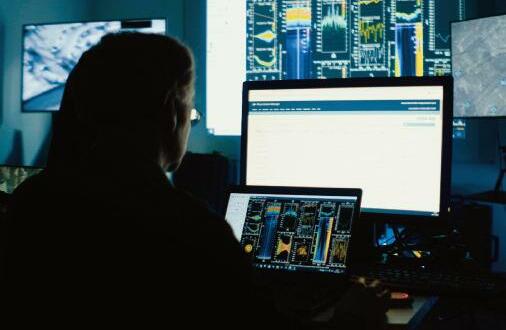
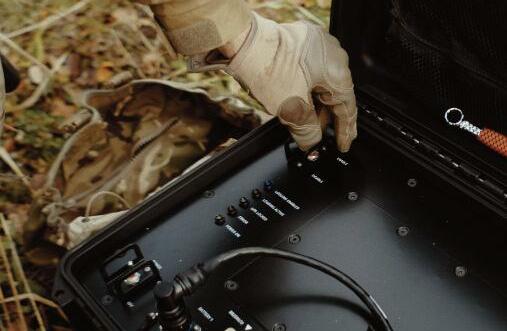
RFeye Stormcase is available now either direct from CRFS or one of our local partners. For more information visit https://www.crfs.com/stormcase/
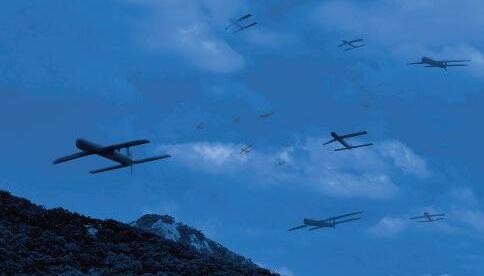
Suicide drone swarms present an asymmetric threat Titanis 35 kW Directed Energy beam director on containerised system
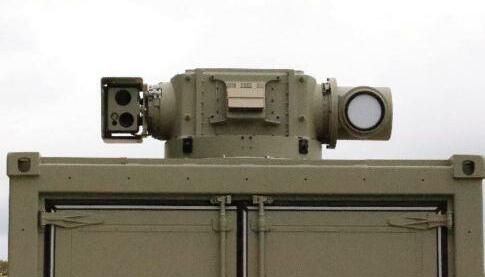
TITANIS DRONE DEFEAT
Counteringthethreatcausedbydrones isnowaglobalissueandanincreasing concernformilitary,governmentand homelandsecurityforcesacross every continent. It is expected that unmanned aerial systems (UAS) will be increasingly used for malicious purposes, given their ability to carry cameras, weapons, toxic chemicals and explosives, and they are already being for acts of terrorism, espionage and smuggling.
EOS has developed the Titanis Counter UAS (CUAS) system to address the growing threat from malicious and threatening UAS.
Based on the EOS R-Series RWS, Titanis is a fully integrated, scalable CUAS suite that combines the speci c detection, command and control (C2), and layered hard and soft kill defeat capabilities necessary to acquire, track and defeat swarming UAS threats.
TheTitanis system allows operators to match kill solutions to large numbers and varying combinations of small and large drones to ensure that the threat can be mitigated regardless of their direction, numbers and capabilities while managing environmental, geographic, airspace and personnel safety considerations.
A typical all-up Titanis con guration incorporates direct- re engagement systems, passive and active soft kill electronic warfare (EW) systems, an integrated sensor suite –including Pulse-Doppler, software-de ned radar, day/thermal camera, laser range nder and radio frequency (RF) detection systems – and an optional Directed Energy (DE) kill system. These systems sit together with, and are integrated through, a proprietary, EOSdeveloped C2 and re control system. series minigun to larger-calibre 30 mm guns (e.g. the Northrop Grumman M230LF 30 mm cannon with EOS R400S Mk2 RWS, or the Mk44 II Bushmaster chain gun with the heavier-weight EOS R800 RWS) ring airburst munitions (including 30 mm × 113 mm proximity fused airbursts and 30 mm × 173 mm airburst rounds) to deliver CUAS effects out to 3000 m.
One of the key differences between CUAS and other missions is the high angular speed that UAS can achieve at relatively short range. EOS RWS have been modi ed with a fourth-axis, independently slewing sensor unit that can move independently in azimuth to track fast-moving targets. A 1 Hz laser provides laser ranging and tracking throughout the engagement.
Passive and active soft kill EW systems designed to operate across all-threat frequency bands are, as with the radar solutions, integrated according to customer preference. Typical solutions include offerings from Blighter in the UK, Echodyne in the US and RADA in Israel.
Titanis ’ DE system has been deployed with a 35 kW high energy laser (HEL), although the HEL in its current format is capable of scaling to around 55 kW. The HEL system has been demonstrated as a small containerised system; however, while the DE beam director is slightly different to a weapons station, it has 60% commonality with the R400S RWS and is therefore effective from deployable platforms.
Developed and manufactured in-house by EOS, the DE system – which includes the beam director and the co-mounted optical target identi cation and tracking system – is designed to address Group I, II and III UAS swarm threats, with high rates of target engagement, out to ranges of 4000 m. The ability to maintain and manage the quality of the beam, the software that ensures precision engagement and drives the process, and all the mechanical designs and architectures are all EOS designs and intellectual property.
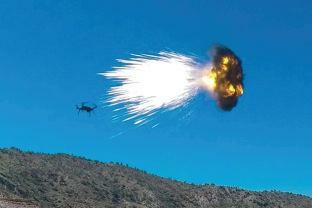
Kinetic CUAS using airburst munition
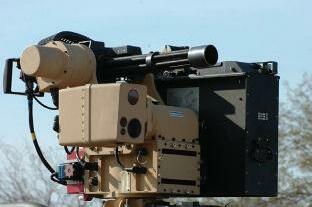
RWS tted with Dillon Aero M134-Series minigun
Arguably, the largest current growth rate in lightweight lethality systems is in the unmanned systems space, both for integration on unmanned platforms with remote operation and for the engagement and defeat of unmanned systems. For CUAS applications, Titanis – with its with direct engagement/point defence, and passive and active EW and DE capabilities – constitutes a signi cant force multiplier.
Acceleration, Vibration, Radiation... It’s A Jungle Up There.

uartz crystal oscillators are the frequency source of choice for a variety of functions in virtually all military and aerospace systems. However some of their superior qualities, such as high frequency stability and low noise, can quickly degrade when they are exposed to the extreme operating environments associated with these applications. S hock and Vibration E ects For oscillators used on mobile platforms, vibration and shock e ects can be signi cant. While crystal oscillators can be designed to withstand extreme levels, these e ects can be the limiting factor that determines the achievable performance in any given system. Random vibration, for example, will show up on the output spectrum of the oscillator as an increase in the noise oor. The amount of degradation is determined by (1) the level of vibration and (2) the acceleration sensitivity of the oscillator. The e ect can range from barely noticeable to catastrophic. The severe vibration experienced on a missile system or other airborne platform can cause phase noise to degrade by as much as 50dB to 60dB. Temperature Ex tremes The temperature conditions often present in military and aerospace environments are another critical factor that impacts signal source performance. The frequency vs. temperature characteristic of the oscillator will be determined primarily by the quartz crystal itself. Most MHz range crystals are cut to conform to a temperature curve in the “AT” family of cuts. The temperature coe cient of these crystals is relatively at compared to other passive components. Even over the wide range of -55°C to +125°C, the frequency error can be as small as ±20ppm. For many applications better stability may be needed – and temperature compensation can be added in order to reduce temperature error to <1ppm. Radiation Environments When a device will be deployed in space, some level of radiation tolerance is required. For satellites deployed in Low Earth Orbit (LEO), radiation tolerance of up to 50 krad(Si) TID (total ionizing dose) is required. TID is a cumulative deteriorating e ect over time at some rate. Deep space and other missions will require a tolerance of 200 krad(Si) TID or greater. Single Event E ects that can occur randomly – due to impact with a heavily charged particle – must also be taken into consideration. Oscillator design for radiation tolerance also demands close attention to all the components that are used in the device. While most passive components are inherently radiation tolerant to a high level, some commercial semiconductors are sensitive to TID levels of only a few thousand krad(Si). Radiation hardened devices are manufactured with special processes and are extensively screened and tested on a lot-by-lot basis, with an attendant increase in cost. The trend for commercial LEO satellite systems, for example, is to carefully evaluate and test lower cost COTS (Commercial-O -The-Shelf) components to nd designs with acceptable performance. This approach requires a certain level of risk acceptance that may not be appropriate for militar y and related applications. Please visit www.greenrayindustries.com for additional resources and information about frequency control solutions for military and aerospace systems and applications.
Q
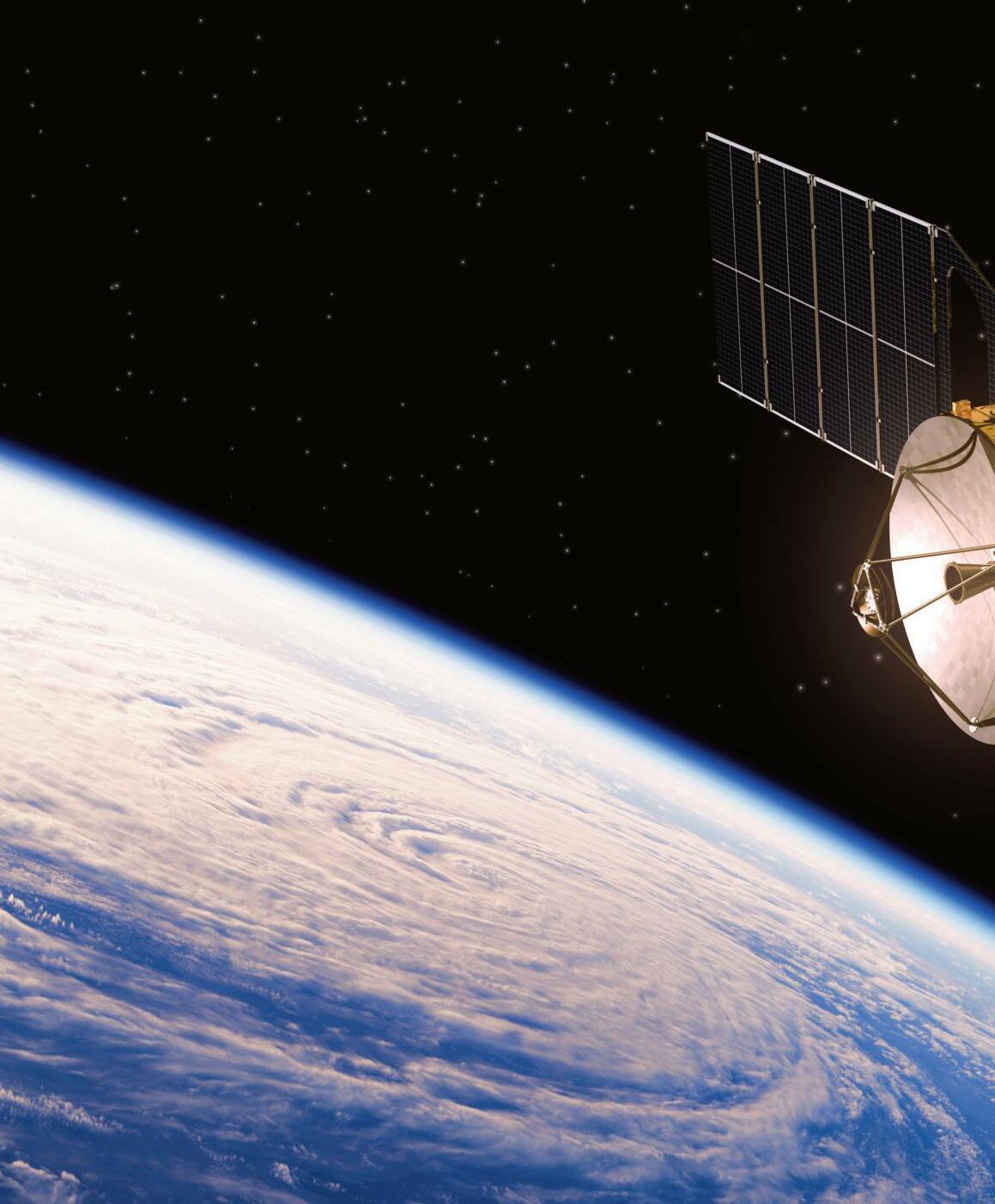


Ultra-High Reliability Reference Sources for Mission Critical Apps.
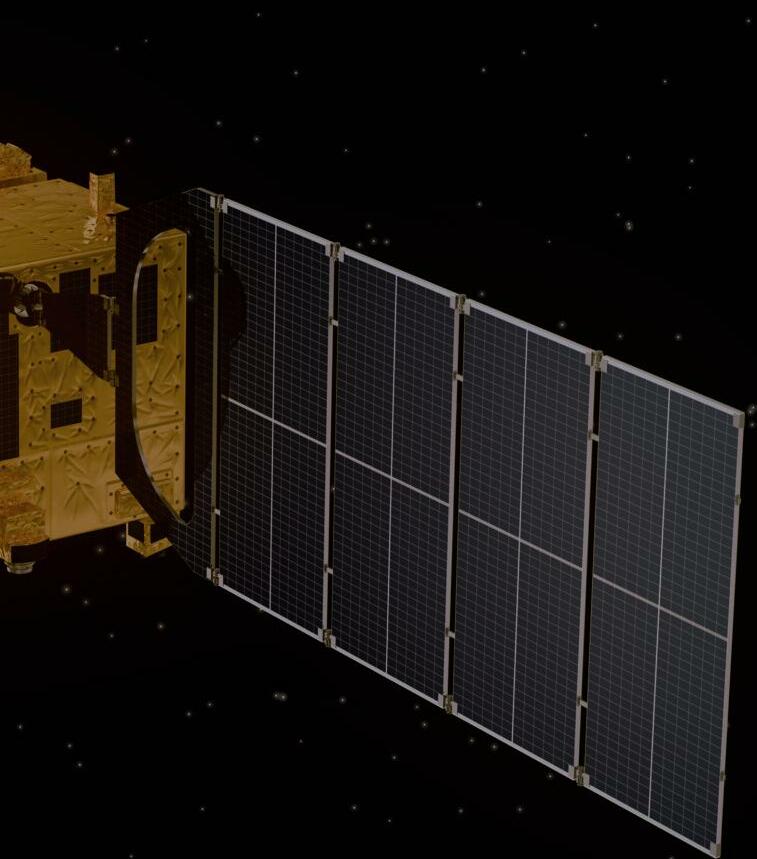
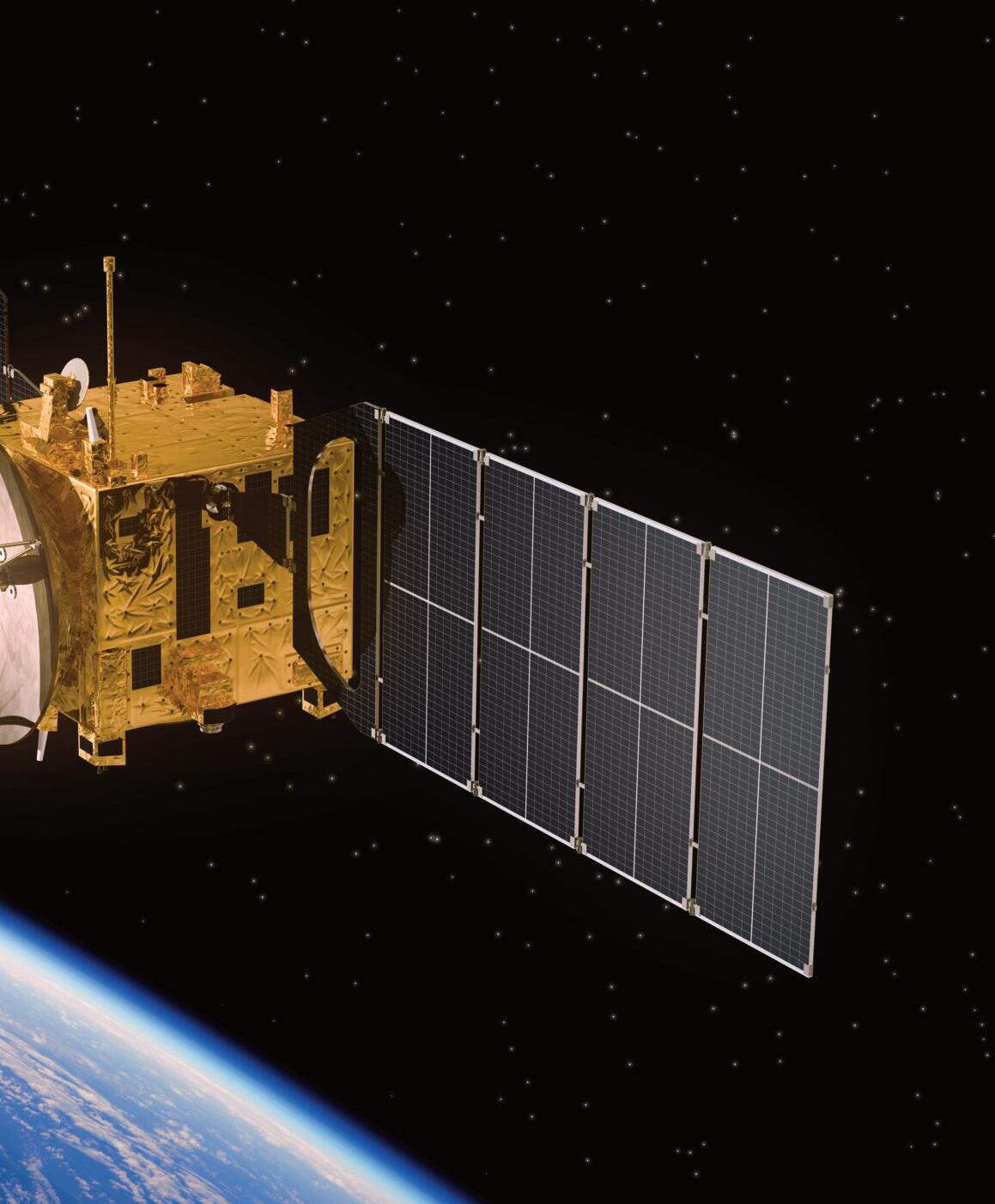
For over 60 years, Greenray quartz crystal oscillators have served as high reliability reference sources for industrial and military applications that require low g-Sensitivity and excellent phase noise in order to optimize system performance while operating under the most demanding environmental conditions. State-of-the-art vibration compensation enables our oscillators to deliver excellent phase noise performance and the short and long-term stability necessary in high shock and vibration environments. Leveraging our extensive design and manufacturing experience, Greenray space-quali ed TCXOs have been designed speci cally for LEO (low earth orbit) satellite applications and/or deep space exploration. They o er guaranteed, long-term performance under radiation exposure from 30 krad(Si) to 200 krad(Si) TID. Our T1254, T1354, T1276 and T1282 Series TCXOs are ideal for high orbit transponders, LEO nano/micro satellites, RF telemetry systems, multiband converters and upconverters. The Y1631 Series clock oscillator is available from 60 to 130 MHz and combines low phase noise and ultra-low g-Sensitivity performance (to 5 x 10-11/g). It features a 0.68”sq. SMT package, +5 Vdc supply and +10 dBm sinewave output. It is ideal for a variety of aerospacespeci c and other applications. For more information, visit us at www.greenrayindustries.com or talk to a frequency control expert today and call Greenray at +1 717-766-0223.

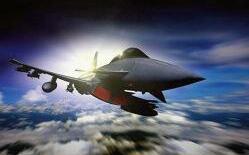
Award-winning Quality, On-Time Delivery & Customer Service Testing & Processes per MIL-PRF-55310 Reliability Calculations, Phase Noise vs. Vibration Testing Certified to ISO-9001:2015 & AS9100D standards IPC-A-610 and J-STD-001 Trained Operators In-House Qualification Testing


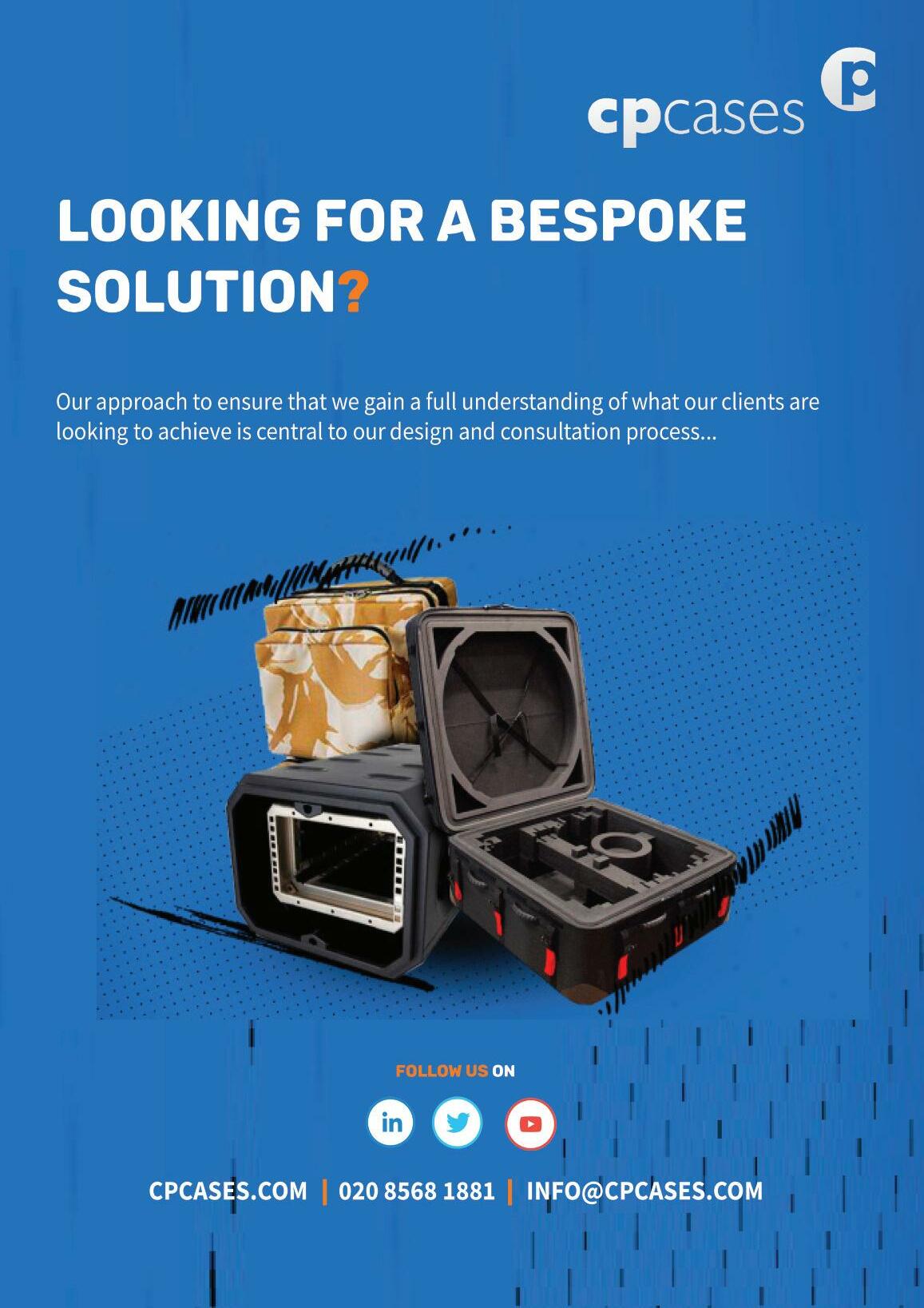
CP CASES NEWS
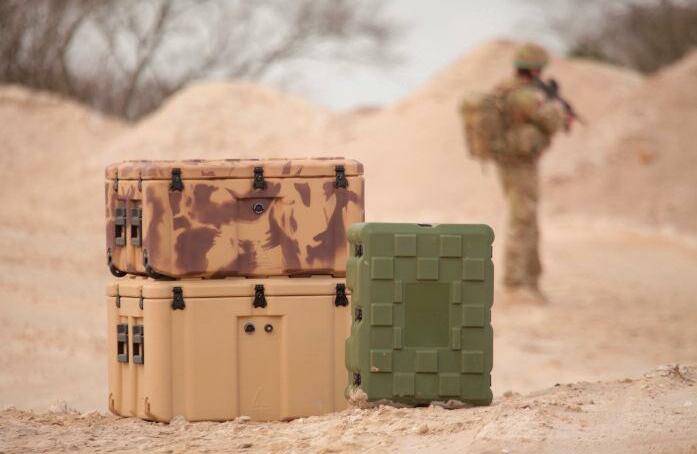
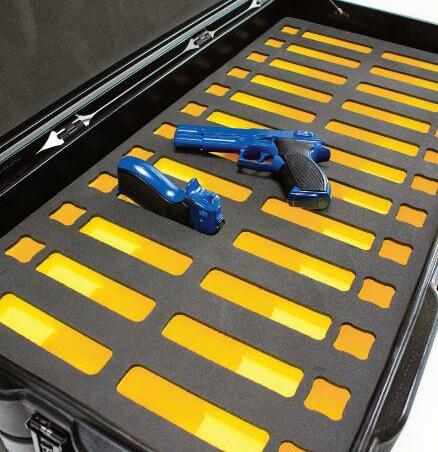
TYPES OF CASES AVAILABLE FOR THE DEFENCE AND SECURITY INDUSTRY
Defence and security industries require military cases that can combat rough handling, extreme climates, environmental hazards and unpredictable conditions. Lifesaving equipment requires the right casing which is why CP Cases offers a variety of different cases with IP ratings from IP54 to IP65. Weapons cases
Transporting military weapons requires rugged cases that can protect expensive equipment from extreme climates and rough handling. Our military weapons cases are tailored to different applications depending on security size, weapon type and more. The key to an effective weapon case is durability which is why CP Cases military cases are resistant to impact, extreme temperatures and water or dust. Nitrogen-blown polyethylene foam inserts eliminate the possibility of chemical contamination or corrosion, meaning weapons are kept safe and in pristine condition. Amazon cases
Amazon cases are designed for military markets made for transit and storage of defence and security equipment. For maximum capacity storage and inter-stackable, amazon cases are the ultimate transportation for military equipment. Made for air transport, amazon military flight cases are moulded from rugged polyethylene that can withstand rough treatment and extreme climates. UV stabilised, easily cleaned and corrosion resistant, these cases are ideal for transit and storage. Helmet cases
Helmets are vital pieces of defence equipment that can save lives. This is why it’s important that they are properly stored so as to protect them during transportation. Our helmet cases are specifically designed for helicopter pilot helmets which cost a great deal of money and so require the most premium cases. Made using AluWeld, these high-tensile aluminium cases offer maximum protection against environmental hazards. Inside the case, we use engineered foam to cushion the helmet and the exterior has been swaged to increase stiffness by 25%. These lightweight cases are practical in design and effective in protecting military helmets. Medical cases
Lifesaving medical supplies need to be transported safely, especially in military situations. CP Cases medical equipment cases provide tough water-resistant transportation for vital medical supplies. With a variety of customisation options, medical cases can be supplied with drawers to help organise and secure medical equipment. Hygiene is paramount when transporting medical equipment which is why our cases are made from polyethylene which has zero fungal growth and is tested to MIL-STD-810F. Extreme military environments require rugged cases to transport and store the highest grade of defence equipment. Having the right storage solutions will ensure that equipment lasts longer and performs at its best. At CP Cases, we have a variety of different custom cases for all defence and security uses.










